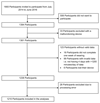Objective Measures of Activity in the Elderly: Distribution and Associations With Demographic and Health Factors
- PMID: 28602617
- PMCID: PMC6276982
- DOI: 10.1016/j.jamda.2017.04.017
Objective Measures of Activity in the Elderly: Distribution and Associations With Demographic and Health Factors
Abstract
Background: Little is known about the distribution of activity over the full 24-hour spectrum in late old age and its association with demographic and health factors. Therefore, we aimed to evaluate the distribution of physical activity (PA), sedentary behavior, and sleep, and associated factors in the elderly population.
Methods: Our study included 1210 participants (51.9% women) aged 70-94 years [mean age 77.5 years, standard deviation (SD) 5.0] from the population-based Rotterdam Study. Participants wore a triaxial accelerometer (GENEActiv) around the wrist for 7 days between July 2014 and June 2016. We examined if PA, sedentary behavior, and sleep differed by age, sex, body mass index (BMI), smoking status, alcohol consumption, education, season, functional capacity, marital status, presence of chronic disease, and use of sleep medication.
Results: Mean total PA, expressed in milli-gravity (mg) units, was slightly higher for women (20.3, SD 5.6) than for men (19.3, SD 5.2, P < .01). Mean (SD) daily duration spent in sedentary behavior and light and moderate-to-vigorous PA was 13.3 (1.5) h/d, 147.5 (31.5) min/d, and 75.0 (25.5) min/d, respectively, among women; and 13.8 (1.6) h/d, 140.5 (31.1) min/d, and 71.5 (24.5) min/d, respectively, among men. Women spent on average 6.7 (SD 1.1) h/d sleeping and men 6.6 (1.4) h/d. Across increasing categories of age and BMI and in participants with chronic disease and disability, time spent in light and moderate-to-vigorous PA was decreased. Higher age and BMI were associated with more sedentary time. In addition, obese men spent slightly more time sleeping than their normal weight counterparts and women spent slightly less time sleeping in the summer than in spring.
Conclusions: PA and sedentary behavior in the elderly differed by sex, age, BMI, prevalence of chronic disease, and disability, whereas there were no clear patterns for sleep. On average, our participants spent up to 79.5% of their time awake being sedentary and 7%-8% in moderate-to-vigorous PA. Replacing sedentary behavior with light PA would be a good starting point for those with the lowest level of PA. Older adults, those with high BMI and worse health could benefit from targeted interventions to increase PA.
Keywords: Physical activity; Rotterdam Study; accelerometer; elderly.
Copyright © 2017 AMDA – The Society for Post-Acute and Long-Term Care Medicine. Published by Elsevier Inc. All rights reserved.
Conflict of interest statement
There are no conflict of interests to declare.
Figures





Similar articles
-
Individual Barriers to an Active Lifestyle at Older Ages Among Whitehall II Study Participants After 20 Years of Follow-up.JAMA Netw Open. 2022 Apr 1;5(4):e226379. doi: 10.1001/jamanetworkopen.2022.6379. JAMA Netw Open. 2022. PMID: 35389501 Free PMC article.
-
Associations of accelerometry-measured and self-reported physical activity and sedentary behavior with skeletal muscle energetics: The Study of Muscle, Mobility and Aging (SOMMA).J Sport Health Sci. 2024 Sep;13(5):621-630. doi: 10.1016/j.jshs.2024.02.001. Epub 2024 Feb 9. J Sport Health Sci. 2024. PMID: 38341136 Free PMC article.
-
Regional Difference in the Impact of COVID-19 Pandemic on Domain-Specific Physical Activity, Sedentary Behavior, Sleeping Time, and Step Count: Web-Based Cross-sectional Nationwide Survey and Accelerometer-Based Observational Study.JMIR Public Health Surveill. 2023 Feb 20;9:e39992. doi: 10.2196/39992. JMIR Public Health Surveill. 2023. PMID: 36634262 Free PMC article.
-
Accelerometer-determined physical activity and self-reported health in a population of older adults (65-85 years): a cross-sectional study.BMC Public Health. 2014 Mar 27;14:284. doi: 10.1186/1471-2458-14-284. BMC Public Health. 2014. PMID: 24673834 Free PMC article. Clinical Trial.
-
Physical activity and sedentary behaviors in postpartum Latinas: Madres para la Salud.Med Sci Sports Exerc. 2013 Jul;45(7):1298-306. doi: 10.1249/MSS.0b013e3182863de5. Med Sci Sports Exerc. 2013. PMID: 23439416 Free PMC article.
Cited by
-
Is Cognitive Reserve a Determinant of Functional and Mental Health in Older People of the Sardinian Blue Zone? A Mediational Approach.Psychiatr Q. 2023 Dec;94(4):617-632. doi: 10.1007/s11126-023-10047-6. Epub 2023 Aug 29. Psychiatr Q. 2023. PMID: 37642822 Free PMC article.
-
Application of Activity Trackers among Nursing Home Residents-A Pilot and Feasibility Study on Physical Activity Behavior, Usage Behavior, Acceptance, Usability and Motivational Impact.Int J Environ Res Public Health. 2020 Sep 14;17(18):6683. doi: 10.3390/ijerph17186683. Int J Environ Res Public Health. 2020. PMID: 32937840 Free PMC article.
-
Effects of physical activity programs on sleep outcomes in older adults: a systematic review.Int J Behav Nutr Phys Act. 2020 Feb 5;17(1):11. doi: 10.1186/s12966-020-0913-3. Int J Behav Nutr Phys Act. 2020. PMID: 32024532 Free PMC article.
-
Substitutions of physical activity, sedentary behaviour and sleep: associations with mental health in middle-aged and elderly persons.J Epidemiol Community Health. 2022 Feb;76(2):175-181. doi: 10.1136/jech-2020-215883. Epub 2021 Jul 22. J Epidemiol Community Health. 2022. PMID: 34301796 Free PMC article.
-
Daily-Life Walking Speed, Quality and Quantity Derived from a Wrist Motion Sensor: Large-Scale Normative Data for Middle-Aged and Older Adults.Sensors (Basel). 2024 Aug 10;24(16):5159. doi: 10.3390/s24165159. Sensors (Basel). 2024. PMID: 39204870 Free PMC article.
References
-
- Gulsvik AK, Thelle DS, Samuelsen SO, Myrstad M, Mowe M, Wyller TB. Ageing, physical activity and mortality--a 42-year follow-up study. Int J Epidemiol. 2012;41(2):521–30. - PubMed
-
- Chief Medical Officer. At least five a week: evidence on the impact of physical activity and its relationship to health. London: Department of Health; 2004.
-
- Keysor JJ. Does late-life physical activity or exercise prevent or minimize disablement? A critical review of the scientific evidence. Am J Prev Med. 2003;25(3 Suppl 2):129–36. - PubMed
-
- Ainsworth BE. How do I measure physical activity in my patients? Questionnaires and objective methods. Br J Sports Med. 2009;43(1):6–9. - PubMed
MeSH terms
Grants and funding
LinkOut - more resources
Full Text Sources
Other Literature Sources

